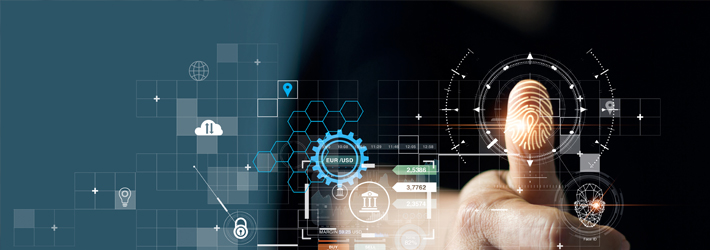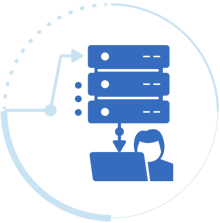
According to a recent study, an astounding 70% of security professionals worry about the risks that insufficient access controls might provide to businesses, including creating a risk of data theft and exploitation. Of those who responded, 40% were extremely concerned about a potential breach brought on by faulty authorization.
Data access control ensures that the right individuals have access to pertinent data when they need it, helping to prevent data breaches and incidents associated with over-provisioning.
What is Data Access Control?
Data access control refers to the collection of rules, practices, and technological tools that govern who has access to data, what they may do with it, and when. It is a strategy used to control how employees in an organization can access files. It entails using the Principle of Least Privilege (PoLP), which controls employee access rights according to their positions within the company and defines and restricts the data they can access.
Not all data, particularly sensitive data, should be accessible to everyone. Data Access Control involves more than just granting or refusing access. It can specify read-only, write, and full control permissions. Protecting sensitive information’s availability, confidentiality, integrity, and privacy through permissions and limits is a crucial component of data management and cybersecurity.

Why Do You Need Data Access Control?
Controlling access to data is vital for numerous reasons impacting security, compliance, efficiency, and accuracy within an organization.
- Data Security: The basis for limiting access to data is security. Data security is more important than ever due to the increased risks of data breaches. Efficient data access management prevents unwanted access and safeguards important data, serving as a barrier against cyber criminals. It lowers the possibility of data breaches, identity theft, and cyberattacks by preventing unauthorized access to private and sensitive information.
- Compliance: In addition to security, compliance depends on limiting access to data. Businesses must put data protection safeguards in place, according to regulatory agencies across all industries. Businesses frequently manage sensitive data that is governed by several laws (such as GDPR, HIPAA, etc.) that call for data access control procedures. Data access control helps businesses make sure they comply with these regulations. Businesses engaged in any aspect of the defense supply chain, for example, must comply with ITAR, which mandates strict safeguards for technical data. Strong data access control can help firms comply with these regulations and prevent heavy fines or expulsion from government or industry marketplaces.
- Prevention of Insider Threats: Not every data threat originates externally. Organizations can prevent insider threats—whether malicious or accidental—by implementing strategic data access controls that restrict information based on employees’ organizational roles and responsibilities. By carefully managing user permissions, companies can significantly reduce potential unauthorized data breaches and minimize the likelihood of internal security incidents through role-based access management and continuous monitoring.
- Efficiency: In terms of efficiency, data access control enhances operations by ensuring only pertinent individuals access specific data. This eliminates unnecessary traffic and accelerates data retrieval thereby boosting productivity. By assigning appropriate roles and permissions, data access control ensures employees can be productive without compromising security.
- Accuracy of Data: Data access control can obtain an accurate record of who accessed data, when, and why, improving accountability and traceability. It also enhances accuracy by restricting data editing to authorized users and reducing errors caused by unintentional or unauthorized changes.
- Audit Trail: An audit trail is a crucial mechanism for organizations to track and document data access and activities, providing a comprehensive record of who accessed specific information, when, and why. By offering precise tracking of user interactions, timestamps, and contextual details, audit trails enhance organizational accountability, support compliance efforts, and enable transparent data governance. This simple yet powerful process allows businesses to monitor data interactions without implementing complex procedures, ultimately improving security, traceability, and operational insights with minimal disruption to existing systems.
Types of Data Access Controls
The organizational structure, desired policies, and the kinds of data access controls offered by the software used to access the data all influence the kind of access control that is put in place for the company. Several types of data access control are listed below:
Discretionary Access Control (DAC)
This sort of access control allows the data owner to choose who can access their data. This type is more adaptable and ideal for small and medium-sized businesses since the owner establishes the rules that govern who is permitted to use the resource. In certain situations, administrators have the authority to control resource access and override user decisions. The owner has all control over this kind of access control, making it the least restrictive. It is necessary to validate each file’s Access Control Language (ACL) in the event of a discrepancy because there is no central authority. However, as more people get involved, the risk of using discretionary access control increases. Due to the lack of central authority over access, administrators have less control over what data is shared, and it might be simple to forget who is sharing what. Users may inadvertently be given access to information that they shouldn’t.
Mandatory Access Control (MAC)
One non-discretionary method of access management is mandatory access control. Because all authorizations and decisions regarding data access are centralized, complete control over who can access what is possible. MAC assigns users access according to resource classification and separates users into groups or compartments. Only resources classified for financial purposes, for instance, would be available to the finance department as a whole. With this kind of access control, the end-user has no control over the permission configuration. Permissions can be changed, revoked, and access controlled by a central authority, such as an administrator or owner. A MAC model bases access on the classification of data and the degree of formal access approval or clearance that users possess. Although it can be challenging to handle, this strategy is employed in military organizations.
Role-Based Access Control (RBAC)
With role-based access control, non-discretionary access is granted at the individual level, going beyond MAC’s group-based method. Access is given according to the role or roles that each user has defined, which represent their duties. Users never have access to anything other than the resources they need. Compared to MAC, this method is more detailed because people can be given authorization according to their role. Since it takes into account each person’s function and demands inside the company, the RBAC model is the most popular control mechanism. It assigns privileges according to the requirements of each person’s position inside the company using the principle of least privilege (POLP). It creates a theoretically straightforward, adaptable, and strong authorization mechanism that lowers the possibility of important resources being accidentally accessed.
Attribute-Based Access Control (ABAC)
An authorization paradigm of the future that offers dynamic access control is the attribute-based access control (ABAC) mechanism. Access is based on the value assigned to a set of variables that are assigned to users and resources in this technique. The factors vary depending on the location and time of access. The ABAC model can be set up to limit access to files, for instance, if an employee asks access to them from an odd geographic location or outside of regular work hours. Define programmatic access to resources using either attribute-based access control or policy-based access control. To decide whether permission is granted, ABAC considers the characteristics of the resource being accessed as well as the user. Although it can be difficult to administer, ABAC enables sophisticated rules that provide even more precise control than RBAC. AWS Identity and Access Management (IAM), one of the most well-known ABAC implementations, provides access to files, databases, and other AWS resources according to the assessed attributes specified in the IAM policy.
How Data Access Control Works?
Controlling access to data is a technical and organizational procedure. They function by confirming the users’ identities to make sure they are who they say they are and by confirming that they are authorized to access the data. You need to document the information you gather, how you utilize it, and how it might be disclosed. The data you gather, its storage location, and the people who must have access to it must all be known to you and under your control. Policies must be put into place utilizing the authorization and authentication features of the software you use to access the data after your data has been identified and described.
- Authentication: Authentication is the first step in data access control, involving the verification of a user’s claimed identity through various methods such as login credentials, passwords, API keys, and preferably two-factor authentication. By implementing multifactor authentication systems, organizations can establish a robust verification process that confirms a user’s identity before granting system access, thereby enhancing overall security and reducing the risk of unauthorized entry.
- Authorization: Authorization verifies if a user with valid credentials is permitted to access or modify a resource. Upon identifying a user, you can verify their credentials against access regulations to determine what they are permitted (and prohibited) to access. based on predetermined regulations, establishes not only the extent of each user’s access to the data but also the actions that the user is permitted to perform.
Data access control must be successful if you uniformly use authentication and authorization throughout your whole environment, both on-premises and in the cloud.
How to Implement Data Access Control
To safeguard the organization’s sensitive data, data access control can be done in several methods. Let us examine some of the ways to implement the data access security:
- Determine Access Requirements: Establishing transparent data access hierarchies that correspond with each employee’s job function is the first step. To drastically lower the chance of data leaks, make sure that each team member has access to only the information required for their particular position. Maintain strict control over data access by reviewing and modifying these access levels on a regular basis to reflect changes in roles or responsibilities. Sensitive information and possible risks are identified as a result of determining access requirements.
- Set Clear Access Control Policy: Creating a transparent framework for controlling access privileges is the next stage. Establish clear rules and put in place automated data access controls that allow access, evaluate it frequently to make sure it’s still relevant, and quickly remove it when it’s no longer needed. This procedure keeps your data protection flexible and responsive by ensuring secure data access and quickly adjusting to changes in organizational structure or personnel roles. By establishing a policy that specifies the procedures for granting access, meeting legal requirements, and preserving security.
- Selecting and Configuring Access Control Model: An organization’s structure and the kind of data it handles should guide the choice of access control strategy. The choice of whether to use a role-based, optional, attribute-based, or required access control architecture is obviously important. Adjust the controls according to the model that was selected. For instance, roles and the access privileges that go along with them would be assigned in a role-based access control architecture.
- Deploying Authorization and Authentication: This is regarded as one of the most crucial implementation methods. Establish procedures to ascertain users’ identities and permission levels. Among other security measures, it might consist of passwords and multi-factor authentication. By using multi-factor authentication (MFA) with state-of-the-art technologies like security tokens and one-time passwords (OTPs), you can raise your security game and add a crucial layer of defense by demanding several forms of verification, which makes illegal access much more difficult. Update and improve your MFA techniques frequently to keep ahead of possible security lapses and guarantee that your data is protected. use facial and fingerprint recognition as biometric authentication techniques to gain access to extremely private data.
- Regular Audit and Updates: Regular audits will guarantee that the controls are operating as intended and that the required adjustments are implemented. Control configurations should be reviewed and updated whenever personnel statuses, positions, or sensitive data are changed.
- Employee Awareness training: The significance of data security, the consequences of data access to the company, prevalent threats, and best practices should all be covered in training for staff members. Human error, which is one of the most frequent causes of data breaches, can be decreased using these training programs.
How Data Access Control Protects Data
Data access control adds an extra degree of protection for data by limiting who is permitted to view particular information. Here are the specifics of its data protection measures.
- Restricting Access: By implementing strong access control procedures in place, businesses can limit access to only those people who require the information to carry out their duties. This reduces possible harm, even from internal dangers.
- Preventive Unauthorized Access: Data access control systems make sure that only people who have been verified can access the data. Using biometrics, password protection, and other measures, this can stop hackers, stalkers, and unauthorized users from accessing private data.
- Monitoring and Auditing: The ability to track who accessed what data and when is one of the key components of data access management, and it may be regularly examined. Because unusual activity can be quickly detected and dealt with, better control is made feasible and misuse is discouraged through proper monitoring and auditing.
- Maintain Compliance: There are stringent laws governing data access in several sectors, such as GDPR for European corporations and HIPAA for the healthcare industry. Data access control helps avoid legal problems by ensuring adherence to these rules.
- Protection against Data Leaks: Sensitive information can be protected even when authorized personnel access it because of data access control techniques like data masking. The final four digits of a customer’s credit card number, for instance, can be all that a customer support agent sees.
- Communicate: To deter any misuse, make sure employees are aware that access to the data they are working with is being tracked. A strong least-privilege policy will be supported by clearly defining the data requirements, and careful data handling will be encouraged by ensuring that all parties know the dangers and consequences of an unintentional data leak.
How does Lepide Help
Lepide Data Security Platform offers a unified solution that integrates data and identity security into a single platform, functioning seamlessly across on-premises and cloud environments. This integration provides a comprehensive view of data access and identity management, forming a solid foundation for an effective defense-in-depth strategy and allowing other security tools to be built upon this strong base.
Lepide Data Security Platform analyses user permissions across your environment and identifies which of your users have excessive permissions based on their data usage patterns. Lepide can then automatically remediate excessive permissions to ensure you maintain a least privilege posture. Using Lepide, companies can automate data access control, limit over-exposure of sensitive data, and reduce their overall risk. Are you interested in how Lepide can assist you with enforcing controlled access? Schedule a demo with one of our engineers.




